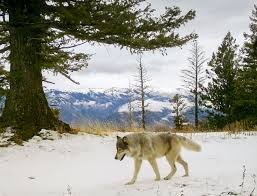
For millennia humans have tried to scare wolves away from their livestock. Most of them didn’t have drones.
But a team of biologists working near the California-Oregon border do, and they’re using them to blast AC/DC’s “Thunderstruck,” movie clips and live human voices at the apex predators to shoo them away from cattle in an ongoing experiment.
“I am not putting up with this anymore!” actor Scarlett Johansson yells in one clip, from the 2019 film “ Marriage Story.”
“With what? I can’t talk to people?” co-star Adam Driver shouts back.
Gray wolves were hunted nearly to extinction throughout the U.S. West by the first half of the 20th century. Since their reintroduction in Idaho and at Yellowstone National Park in the mid-1990s, they’ve proliferated to the point that a population in the Northern Rockies has been removed from the endangered species list.
There are now hundreds of wolves in Washington and Oregon, dozens more in northern California, and thousands roaming near the Great Lakes.
The recovering population has meant increasing conflict with ranchers — and increasingly creative efforts by the latter to protect livestock. They’ve turned to electrified fencing, wolf alarms, guard dogs, horseback patrols, trapping and relocating, and now drones. In some areas where nonlethal efforts have failed, officials routinely approve killing wolves, including last week in Washington state.
Gray wolves killed some 800 domesticated animals across 10 states in 2022, a previous Associated Press review of data from state and federal agencies found.
Scientists with the USDA Animal and Plant Health Inspection Service developed the techniques for hazing wolves by drone while monitoring them using thermal imaging cameras at night, when the predators are most active. A preliminary study released in 2022 demonstrated that adding human voices through a loudspeaker rigged onto a drone can freak them out.
The team documented successful interruptions of wolf hunts. When Dustin Ranglack, the USDA’s lead researcher on the project, saw one for the first time, he smiled from ear to ear. “If we could reduce those negative impacts of wolves, that is going to be more likely to lead to a situation where we have coexistence,” Ranglack said.
The preloaded clips include recordings of music, gunshots, fireworks and voices. A drone pilot starts by playing three clips chosen at random, such as the “Marriage Story” scene or “Thunderstruck,” with its screams and hair-raising electric guitar licks.
If those don’t work, the operator can improvise by yelling through a microphone or playing a different clip that’s not among the randomized presets. One favorite is the heavy metal band Five Finger Death Punch ‘s cover of “Blue on Black,” which might blast the lyric “You turned and you ran” as the wolves flee.
USDA drone pilots have continued cattle protection patrols this summer while researching wolf responses at ranches with high conflict levels along the Oregon-California border. Patrols extended south to the Sierra Valley in August for the first time, according to the California Department of Fish and Wildlife.
It’s unclear whether the wolves might become accustomed to the drones. Herders and wolf hunters in Europe have long deterred them with long lines hung with flapping cloth, but the wolves can eventually learn that the flags are not a threat.
Environmental advocates are optimistic about drones, though, because they allow for scaring wolves in different ways, in different places.
“Wolves are frightened of novel things,” said Amaroq Weiss, a wolf advocate with the Center for Biological Diversity. “I know that in the human imagination, people think of wolves as big, scary critters that are scared of nothing.”
There are also drawbacks to the technology. A drone with night vision and a loudspeaker costs around $20,000, requires professional training and doesn’t work well in wooded areas, making it impractical for many ranchers.
Ranchers in Northern California who have hosted USDA drone patrols agree that they have reduced livestock deaths so far.




